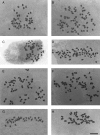Cytotype diversity and genome size variation in eastern Asian polyploid Cardamine (Brassicaceae) species
- PMID: 20007978
- PMCID: PMC2814755
- DOI: 10.1093/aob/mcp282
Cytotype diversity and genome size variation in eastern Asian polyploid Cardamine (Brassicaceae) species
Abstract
Background and aims: Intraspecific ploidy-level variation is an important aspect of a species' genetic make-up, which may lend insight into its evolutionary history and future potential. The present study explores this phenomenon in a group of eastern Asian Cardamine species.
Methods: Plant material was sampled from 59 localities in Japan and Korea, which were used in karyological (chromosome counting) and flow cytometric analyses. The absolute nuclear DNA content (in pg) was measured using propidium iodide and the relative nuclear DNA content (in arbitrary units) was measured using 4,6-diamidino-2-phenylindole fluorochrome.
Key results: Substantial cytotype diversity was found, with strikingly different distribution patterns between the species. Two cytotypes were found in C. torrentis sensu lato (4x and 8x, in C. valida and C. torrentis sensu stricto, respectively), which displays a north-south geographical pattern in Japan. Hypotheses regarding their origin and colonization history in the Japanese archipelago are discussed. In Korean C. amaraeiformis, only tetraploids were found, and these populations may in fact belong to C. valida. C. yezoensis was found to harbour as many as six cytotypes in Japan, ranging from hexa- to dodecaploids. Ploidy levels do not show any obvious geographical pattern; populations with mixed ploidy levels, containing two to four cytotypes, are frequently observed throughout the range. C. schinziana, an endemic of Hokkaido, has hexa- and octoploid populations. Previous chromosome records are also revised, showing that they are largely based on misidentified material or misinterpreted names.
Conclusions: Sampling of multiple populations and utilization of the efficient flow cytometric approach allowed the detection of large-scale variation in ploidy levels and genome size variation attributable to aneuploidy. These data will be essential in further phylogenetic and evolutionary studies.
Figures



References
-
- Baack EJ. Cytotype segregation on regional and microgeographic scales in snow buttercups (Ranunculus adoneus: Ranunculaceae) American Journal of Botany. 2004;91:1783–1788. - PubMed
-
- Baack EJ. To succeed globally, disperse locally: effects of local pollen and seed dispersal on tetraploid establishment. Heredity. 2005;94:538–546. - PubMed
-
- Cain ML, Milligan BG, Strand AE. Long-distance seed dispersal in plant populations. American Journal of Botany. 2000;87:1217–1227. - PubMed
-
- Carlsen T, Bleeker W, Hurka H, Elven R, Brochmann C. Biogeography and phylogeny of Cardamine (Brassicaceae) Annals of the Missouri Botanical Garden. 2009;96:215–236.

